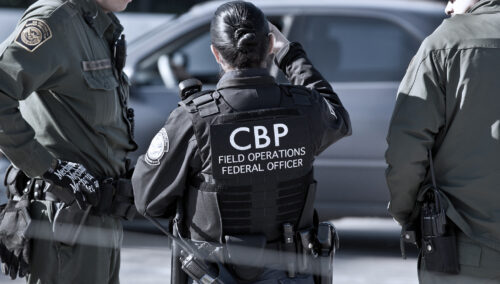If the United States wants effective border security, then more effective law‐enforcement measures must be taken. The first step is to identify the right target: the increasingly sophisticated smuggling organizations known as the “cartels.” By attacking the money laundering which is the life blood of the cartels, and making the bi‐national criminal investigation and prosecution of cartel bosses a priority, the border can be made significantly more secure. In the process, the violence in Mexico and the smuggling of drugs and people into the United States will be reduced. But this requires a unified focus, with state and federal law‐enforcement agencies cooperating to target organized criminal activity rather than economic migrants.
As described in the How to Fix a Broken Border series of papers, written by former Arizona Attorney General Terry Goddard, an effective border‐enforcement strategy must do the following:
Adopt a Coordinated, Multi‐dimensional, Bi‐national Approach
- We must stop compartmentalizing border objectives by illegal activity. Current agency efforts are incorrectly focused on stopping particular kinds of contraband. But a successful effort cannot be about unauthorized immigrants alone (Immigration and Customs Enforcement), or drugs alone (Drug Enforcement Agency), or guns alone (Alcohol, Tobacco, and Firearms). It must address, disrupt, and destroy the total business of the cartels.
- We need a comprehensive, bi‐national, border‐wide strategy that includes federal authorities and Mexican law enforcement, as well as state and local police.
Target Cartel Money
- A more effective border‐enforcement strategy starts with the money. Billions of dollars in illegal revenue from the sale of drugs and other contraband flows into cartel pocketbooks each year. This revenue crosses the border, from the United States into Mexico, by many means, ranging from bulk cash shipments and wire transfers to funnel bank accounts and stored value devices.
- Any serious border defense must go after the cartel’s money, but that is not happening. U.S. Treasury Department officials who observe and regulate the international movement of currency remain unwilling or unable to go after money laundering across the Mexican border.
- Generally speaking, the failures of the anti‐money laundering effort are not because of inadequate statutes, but a failure of enforcement. Again and again, huge amounts of funds flowing illegally out of this country could be stopped if financial institutions and government agencies focused on the problem and aggressively policed unlawful or questionable behavior.
- Current federal law limits the circumstances under which prosecutors can seize the cash they believe to be part of a criminal scheme. In contrast, Arizona law makes it far easier to hold suspected funds pending further examination of their source. Expanding federal authority, with appropriate safeguards, would enhance anti‐money laundering efforts.
Close Money‐Laundering Loopholes
- The cross‐border movement of “stored value” devices is a particularly critical problem. These innocent‐looking plastic cards can contain thousands if not millions of dollars and are not covered by any currency disclosure requirements at the border.
- Under U.S. law, no traveler may take over $10,000 in cash or cash equivalents, called “monetary instruments,” into or out of the United States without declaring that money at the border.
- However, stored value devices are not listed as monetary instruments or otherwise subject to declaration at the border, even though they could contain many times the $10,000 disclosure threshold.
- This loophole, clearly identified by federal authorities over five years ago, provides smugglers with a massive opportunity to evade anti‐money laundering security at the border.
- The U.S. government must enforce existing anti‐money laundering provisions, and quickly close existing loopholes, to stop (or at least slow down) the cash flowing to the cartels. Until government agencies, especially Treasury, get more serious about cutting off the illegal international flow of funds, we can never say we have a “secure” border.
Go After Cartel Bosses
- Current law‐enforcement efforts primarily target low‐level subcontractors for the cartels.
- This country must focus on the arrest and incarceration of cartel leaders. We need to send a clear message that it will be extremely hazardous for anyone to take a fallen leader’s place.
- For example, the arrest, prosecution, and incarceration of Chapo Guzman, the notorious leader of the Sinaloa cartel, would significantly boost our border‐enforcement efforts.
- Ultimately, going after the cartel bosses will require federal leadership and close cooperation with the law enforcement of Mexico. The lack of bi‐national coordination, in effect, provides cartel leaders a sanctuary south of the border.
Protect Ports of Entry
- One of the consequences of the hysteria about border security is the buildup of the Border Patrol at the expense of customs enforcement. With the de‐emphasis on customs inspections, more contraband gets through the ports.
- By appearing tough—making fortification of the border with additional Border Patrol the top priority, while deemphasizing the ports of entry—it is now easier for the criminals to come through our front door.
- Most of the criminal activity has shifted to the border crossings, not the places in between. We need more resources for inspections at ports of entry.
If this country wants to stop smuggling, we must take a broader and more analytical approach to what motivates the smugglers—and the means by which they illegally move drugs, money, guns, and people in such large volumes with such impunity. Going after the contraband product or smuggled people, as this country has been doing for years, is destined to be an endless chase. The cartels will just regroup and continue operations, learning from their mistakes. If we are serious about stopping the threat on the border, we have to dismantle the criminal organizations that carry the contraband and take away the tools that make them so effective. Anything less will fail.



